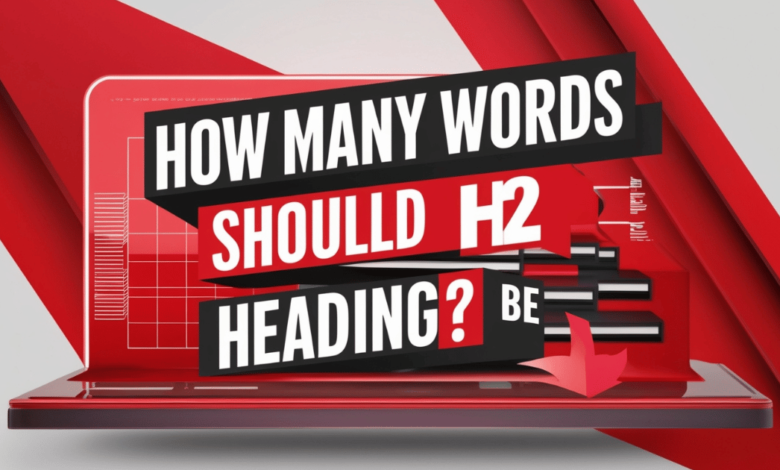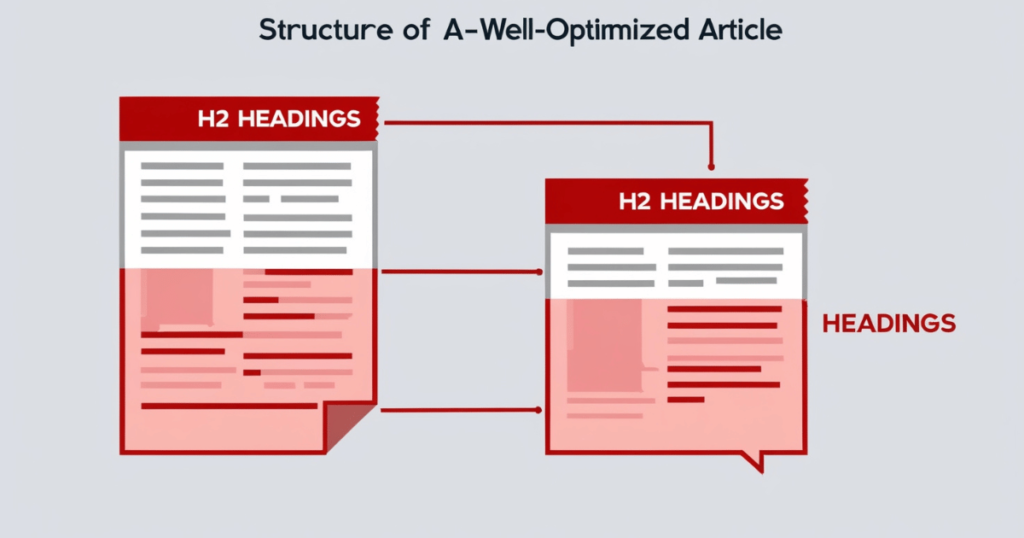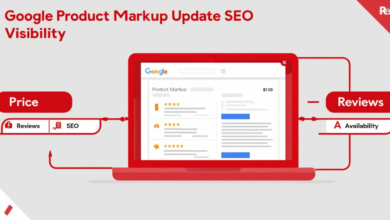
When creating content, whether for a blog, website, or article, it’s essential to structure it effectively. One of the crucial elements of this structure is the use of headings, especially H2 headings. They play a pivotal role in guiding readers and improving SEO. But how many words should H2 headings be? This article will explore this topic in depth, providing insights, best practices, and actionable tips to help you optimize your headings effectively.
The Importance of Headings in SEO
Understanding Headings
Headings are HTML elements that define the structure of your content. They range from H1 to H6, with H1 being the main title and H2 headings representing subheadings under that title. These headings help organize content, making it easier for readers to navigate and for search engines to understand the main topics of a webpage.
Why H2 Headings Matter
H2 headings serve as a roadmap for your content. They break down sections into digestible parts, allowing readers to scan the article easily. From an SEO perspective, using relevant keywords in H2 headings can significantly improve your content’s visibility on search engines.
Thus, knowing how many words H2 headings should be is not just a matter of preference; it directly influences how your content is perceived by both users and search engines.
How Many Words Should H2 Headings Be?
Recommended Length
When determining the optimal word count for H2 headings, the general consensus is to keep them between 3 to 8 words. This length strikes a balance between clarity and conciseness. Short headings are easier to read and understand, while slightly longer headings can provide more context.

- 3-5 Words: Ideal for straightforward topics. For instance, a heading like “How to Use H2 Headings” is concise yet informative.
- 6-8 Words: This allows for a bit more detail while still being manageable. An example could be “How Many Words Should H2 Headings Be for SEO?”
Why This Length?
Readability and User Engagement
A critical factor in content performance is readability. H2 headings that are too long can confuse readers and may lead to disengagement. On the other hand, headings that are too short may lack the necessary context to inform the reader effectively. By keeping H2 headings within the 3 to 8-word range, you create a better user experience, which can decrease bounce rates and improve overall engagement metrics.
SEO Considerations
Search engines favor content that is structured logically. H2 headings provide a clear indication of what the subsequent content covers, making it easier for algorithms to index and rank the page. By incorporating relevant keywords into your H2 headings, you not only improve clarity but also enhance SEO performance.
For instance, if your article is about “how many words should H2 headings be,” using this exact phrase in an H2 heading would be beneficial.
Best Practices for Writing H2 Headings
Use Keywords Wisely
As mentioned, incorporating your focus keyword naturally into your H2 headings is essential. However, avoid overstuffing keywords, as this can lead to penalties from search engines. Aim to use the keyword “how many words should H2 headings be” in a way that feels organic.
Clarity is Key
Make sure your H2 headings clearly reflect the content that follows. If readers can’t determine what a section is about from the heading, they may lose interest and navigate away.
For example:
- Bad Example: “Important Information”
- Good Example: “How Many Words Should H2 Headings Be for Better SEO?”
Keep It Consistent
Maintain a consistent format for your H2 headings throughout the article. This not only improves the visual appeal but also enhances user experience. Consistency helps readers know what to expect as they navigate through your content.
Avoid Jargon
While it’s essential to convey your message effectively, avoid using jargon that may alienate your audience. Use simple, straightforward language that anyone can understand. This approach helps in engaging a broader audience.
Examples of Effective H2 Headings
Effective H2 Headings
- How Many Words Should H2 Headings Be for SEO?
- Understanding the Importance of H2 Headings
- Best Practices for Crafting H2 Headings
- The Role of H2 Headings in User Engagement
- How to Optimize H2 Headings for Search Engines
Ineffective H2 Headings
- A Look into Headings
- Headings and Their Significance
- Different Types of Headings
- Why Headings Matter
- Information on H2 Headings
The effective H2 headings are direct and include the focus keyword, while the ineffective headings are vague and do not provide specific information.
H2 Headings and User Experience
Enhancing Navigation
H2 headings play a crucial role in enhancing the navigation experience for users. They allow readers to scan the content quickly and locate the information they need. By breaking your article into sections with clear H2 headings, you improve the overall usability of your content.
Increasing Time on Page
Content that is easy to navigate often leads to increased time on page. When readers can find what they are looking for quickly, they are more likely to stay longer, which positively affects SEO rankings. This relationship further emphasizes the importance of optimizing H2 headings for readability and clarity.
Encouraging Engagement
Engaging content often results in higher interaction rates, such as comments and shares. Well-crafted H2 headings can encourage readers to engage with your content more deeply, leading to higher levels of interaction and social sharing.
The Relationship Between H2 Headings and SEO
Search Engine Ranking Factors
Several factors contribute to how search engines rank content. While many focus on backlinks and content quality, the structure of your headings is equally important. H2 headings help search engines understand the context and hierarchy of information within your article.
Keyword Placement
As previously stated, placing relevant keywords in your H2 headings can enhance your content’s SEO. However, it’s important to do this strategically. Instead of cramming your keywords into every heading, focus on using them in a few well-placed H2 headings throughout your article.
The Impact of Heading Structure
A well-structured heading hierarchy (H1, H2, H3, etc.) signals to search engines the main topics and subtopics of your content. This structure can lead to better indexing and higher chances of ranking for relevant queries. For instance, if your article discusses various aspects of headings, having multiple H2 headings that cover different angles can significantly improve your SEO performance.
How Many H2 Headings Should Be in an Article?
Recommended Number
For an article exceeding 1700 words, it’s advisable to include at least 5 to 8 H2 headings. This quantity allows for sufficient organization and clarity without overwhelming the reader. The exact number can vary based on the content complexity, but ensuring a balanced distribution of headings is essential.

Balancing Content and Headings
While it’s crucial to include H2 headings for structure, they should not be forced into your content. Ensure that each H2 heading serves a purpose and reflects the content of the section it introduces.
Example Distribution
For an article like this one, which exceeds 1700 words, you might structure it as follows:
- Introduction (1 H2 Heading)
- Main Content Sections (4-6 H2 Headings)
- Conclusion (1 H2 Heading)
This distribution ensures that your content is logically organized and easy to follow, which enhances both user experience and SEO.
Testing and Iterating on H2 Headings
The Importance of A/B Testing
A/B testing allows you to experiment with different H2 headings and formats to see which performs better. By analyzing user engagement metrics, such as time on page and click-through rates, you can identify which headings resonate most with your audience.
Monitoring Performance
Keep track of how changes in your H2 headings affect your overall content performance. Using analytics tools can help you measure engagement and make data-driven decisions to optimize your headings further.
Iteration for Improvement
Content optimization is an ongoing process. Regularly review your H2 headings and adjust them based on performance data and changing audience preferences.
Conclusion: Crafting the Perfect H2 Headings
In summary, understanding how many words should H2 headings be is essential for creating effective and SEO-friendly content. The ideal range for H2 headings is between 3 to 8 words, allowing for clarity and engagement without overwhelming the reader.
By incorporating relevant keywords naturally, maintaining a consistent format, and avoiding jargon, you can craft H2 headings that enhance both user experience and search engine visibility. Regularly testing and iterating on your headings will ensure that your content remains competitive and engaging.
Final Thoughts
The role of H2 headings in content creation cannot be overstated. They are not just a formality; they are a crucial element that impacts SEO, user engagement, and overall content effectiveness. By following the guidelines outlined in this article, you can optimize your H2 headings and elevate your content to new heights.
FAQs
Q1: How many words should H2 headings be for effective SEO?
A1: When considering how many words should H2 headings be, the ideal length is between 3 to 8 words. This range helps maintain clarity and enhances SEO performance.
Q2: Why is it important to know how many words should H2 headings be?
A2: Understanding how many words should H2 headings be is crucial because it impacts both user engagement and search engine ranking. Clear and concise H2 headings improve readability and make content more accessible to search engines.
Q3: Can I effectively use keywords in H2 headings while considering how many words should H2 headings be?
A3: Yes! It’s essential to incorporate relevant keywords in H2 headings, considering how many words should H2 headings be. Doing so not only enhances SEO but also makes your content more relevant to users.
Q4: For a 1700-word article, how many H2 headings should I have, considering how many words should H2 headings be?
A4: In a 1700-word article, you should aim for 5 to 8 H2 headings. This structure allows for a logical flow of information while ensuring that each heading remains within the recommended word count.
Q5: What methods can I use to determine how many words should H2 headings be for optimal engagement?
A5: To determine how many words should H2 headings be for optimal engagement, consider using A/B testing to analyze user interaction with different headings. Monitoring analytics can also provide insights into which heading lengths resonate best with your audience.



